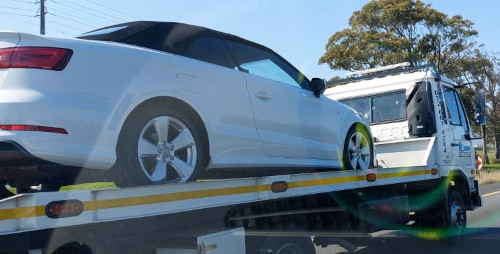ON-BOARD DIAGNOSTICS
A few days ago I was driving behind a string of cars through
Liesbeek Parkway
when I was startled by several drivers repeatedly hooting at an Audi
A4 driving in front of them to get out of the way or change lane. The Audi
A4 that was holding up the traffic had a Guateng registration plate
and my first impression was that its occupants got lost at the
spaghetti junction fly-over, not knowing which off ramp to take.
However when these impatient hooting drivers finally overtook the Audi
A4 and I got to drive behind it; I then realized that the Audi A4 was
in fact in Limp Mode. Its driver was attempting to get to the
shoulder of the road
from the centre lane and the traffic just wasn't easing up.
In my opinion, these impatient driver just weren't aware that when a
vehicle goes into Limp Mode it cannot go any faster than it's already
going even though its driver was
flooring the accelerator pedal. And I may add that ignorance about Limp Mode is no excuse, because its been around since 1996.
DRIVER COURTESY
Driver courtesy is very important to bolster safe driving conditions for
everyone but
an education
regarding Limp Mode would be considered far more
important. When a car suddenly reduces speed after driving at normal speed, it could
be one of several reasons; among which could be steering vibration due to
a puncture. Or the vehicle ran out of fuel. Or the engine may have
switched off due to a dead battery caused by either alternator issues or
snapped fan belt.
Or the engine may be overheating, or the driver heard a disturbing noise
coming from the engine. Or it could be an
electrical fault like a faulty fuel pump
or an ignition system failure like a defective engine or transmission
control unit. Or the driver could have fell ill behind the wheel, to
mention but a few of the myriad of reasons why a vehicle could stall or it
may have entered in Limp Mode.
AUTOMATIC TRANSMISSIONS
The engines of cars with automatic transmissions can sometimes switch off
mid travel for some obscure reason. The only option the driver has, is to
pull off the road, bring the car to a halt, place it in park or neutral to
restart the engine. I know of someone who shifted his
automatic transmission into neutral
when the engine cut out mid travel, restarted the car and shifted it back
into drive. This caused his car to almost come to a stand-still instantly
causing the wheels to screech as the engines inhibited the
transmission. This type of action can and probably will damage the
transmission subject to the gearing system inside and should never be done.
Unfortunately no On-board diagnostics makes provision to prevent this.
When an engine cuts out at say 100kph both the power steering and vacuum
boosted brakes stops working, thereby making steering difficult and the
braking inefficient. It is therefore best to pull off onto the
shoulder of the road and check what the problem is an remedy it before
continuing on your journey.
ON-BOARD DIAGNOSTICS
On-Board Diagnostics does a pretty decent job of protecting the engine and transmission against damage by limiting acceleration, keeping the engine revs to a maximum of 2000 (RPM) and speed to about 45kph - aka Limp Mode. When Limp Mode is enabled, it may lock an automatic transmission in low gear and even disable both heating and air conditioning. Yet keeping the engine running so that it can be driven to a repair shop.
However, as clever as an ECU is, it doesn't do anything to alert the
driver of the car that follows close behind.
Considering tail lights, brake light, reverse lights and indicators
represents a language used by vehicle drivers for those following
behind, to indicate their driving intentions.
This light language that's been around for the better part of the automotive
industry's existence yet it still haven't come-up with an appropriate and
safe warning sign/method for Limp Mode.
LIMP MODE INDICATOR
To remedy this, car manufacturers could include flashing hazard lights or perhaps fit an LED Display with a scrolling message along the the rear window as an alert to tell the driver following behind that the car in front of it has gone into Limp Mode. Alternatively, electronics savvy car owners can fit their own aftermarket hack by identifying the switching output of the appropriate automotive High Side Switch (HSS) responsible for protection and diagnostics inside the ECU when Limp Mode is enabled.
This may not be as easy as it may seem or sounds because of the myriad of
automotive chip manufactures, each pushing their our integrated circuits
(ICs) running custom/propriety software, among which are Infineon Technologies AG, Robert Bosch,
Qualcomm, Renesas Electronics Corporation (Intersil), NXP Semiconductors, STMicroelectronics, Texas Instruments, Intel and Microchip
Technology Inc, etc.
However, most of these manufacturers produce Power Switches and incorporate Open Load Detection in their design so that they can perform open-circuit diagnosis on loads, such wiper motors, fans, head lamps, fuel
pump, mirrors, actuators in general and LED lights while the load is enabled or disabled. Open load diagnosis is probably the most important function of the
software driven
High-Side Switch (HSS) and Low-Side Switch when wired in a specific configuration which allows
for currents from 5mA to more than 10A to be accurately
detected.
As such able to generate a hardware signal (Limp Mode signal) that can directly control the hardware without the participation of the microprocessor in the ECU. This output can be used to as either a digital High of Low (using CMOS
inverter) to drive a LED display that flashes LIMP MODE..... LIMP MODE..... LIMP MODE.....


















